Obama's secret kill list – the disposition matrix
The disposition matrix is a complex grid of suspected terrorists to be traced then targeted in drone strikes or captured and interrogated. And the British government appears to be colluding in it
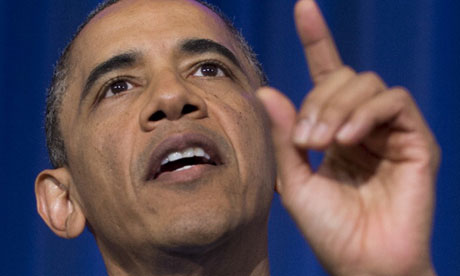
Barack Obama, chairing the 'Terror Tuesday' meetings, agrees the final schedule of names on the disposition matrix. Photograph: Saul Loeb/AFP/Getty Images
When Bilal Berjawi spoke to his wife for the last time, he had no way of being certain that he was about to die. But he should have had his suspicions.
A short, dumpy Londoner who was not, in the words of some who knew him, one of the world's greatest thinkers, Berjawi had been fighting for months in Somalia with al-Shabaab, the Islamist militant group. His wife was 4,400 miles away, at home in west London. In June 2011, Berjawi had almost been killed in a US drone strike on an al-Shabaab camp on the coast. After that he became wary of telephones. But in January last year, when his wife went into labour and was admitted to St Mary's hospital in Paddington, he decided to risk a quick phone conversation.
A few hours after the call ended Berjawi was targeted in a fresh drone strike. Perhaps the telephone contact triggered alerts all the way fromCamp Lemmonier, the US military's enormous home-from-home at Djibouti, to the National Security Agency's headquarters in Maryland. Perhaps a few screens also lit up at GCHQ in Cheltenham? This time the drone attack was successful, from the US perspective, and al-Shabaab issued a terse statement: "The martyr received what he wished for and what he went out for."
The following month, Berjawi's former next-door neighbour, who was also in Somalia, was similarly "martyred". Like Berjawi, Mohamed Sakr had just turned 27 when he was killed in an air strike.
Four months later, the FBI in Manhattan announced that a third man from London, a Vietnamese-born convert to Islam, had been charged with a series of terrorism offences, and that if convicted he would face a mandatory 40-year sentence. This man was promptly arrested by Scotland Yard and is now fighting extradition to the US. And a few weeks after that, another of Berjawi's mates from London was detained after travelling from Somalia to Djibouti, where he was interrogated for months by US intelligence officers before being hooded and put aboard an aircraft. When 23-year-old Mahdi Hashi next saw daylight, he was beingled into a courtroom in Brooklyn.
That these four men had something in common is clear enough: they were all Muslims, all accused of terrorism offences, and all British (or they were British: curiously, all of them unexpectedly lost their British citizenship just as they were about to become unstuck). There is, however, a common theme that is less obvious: it appears that all of them had found their way on to the "disposition matrix".
The euphemisms of counter-terrorism
When contemplating the euphemisms that have slipped into the lexicon since 9/11, the adjective Orwellian is difficult to avoid. But while such terms as extraordinary rendition, targeted killing and enhanced interrogation are universally known, and their true meanings – kidnap, assassination, torture – widely understood, the disposition matrix has not yet gained such traction.
Since the Obama administration largely shut down the CIA's rendition programme, choosing instead to dispose of its enemies in drone attacks, those individuals who are being nominated for killing have been discussed at a weekly counter-terrorism meeting at the White House situation room that has become known as Terror Tuesday. Barack Obama, in the chair and wishing to be seen as a restraining influence, agrees the final schedule of names. Once details of these meetings began to emerge it was not long before the media began talking of "kill lists". More double-speak was required, it seemed, and before long the term disposition matrix was born.
In truth, the matrix is more than a mere euphemism for a kill list, or even a capture-or-kill list. It is a sophisticated grid, mounted upon a database that is said to have been more than two years in the development, containing biographies of individuals believed to pose a threat to US interests, and their known or suspected locations, as well as a range of options for their disposal.
It is a grid, however, that both blurs and expands the boundaries that human rights law and the law of war place upon acts of abduction or targeted killing. There have been claims that people's names have been entered into it with little or no evidence. And it appears that it will be with us for many years to come.
The background to its creation was the growing realisation in Washington that the drone programme could be creating more enemies than it was destroying. In Pakistan, for example, where the government estimates that more than 400 people have been killed in around 330 drone strikes since 9/11, the US has arguably outstripped even India as the most reviled foreign country. At one point, Admiral Mike Mullen, when chairman of the US joint chiefs of staff, was repo rted to be having furious rows over the issue with his opposite number in Pakistan, General Ashfaq Kayani.
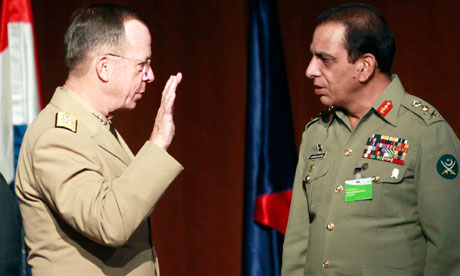 Admiral Mike Mullen (left), when chairman of the US joint chiefs of staff, was reported to have furious rows over the drone programme with his opposite number in Pakistan, General Ashfaq Kayani (right). Photograph: Javier Diaz/Reuters
Admiral Mike Mullen (left), when chairman of the US joint chiefs of staff, was reported to have furious rows over the drone programme with his opposite number in Pakistan, General Ashfaq Kayani (right). Photograph: Javier Diaz/Reuters
The term entered the public domain following a briefing given to the Washington Post before last year's presidential election. "We had a disposition problem," one former counter-terrorism official involved in the development of the Matrix told the Post. Expanding on the nature of that problem, a second administration official added that while "we're not going to end up in 10 years in a world of everybody holding hands and saying 'we love America'", there needed to be a recognition that "we can't possibly kill everyone who wants to harm us".
Drawing upon legal advice that has remained largely secret, senior officials at the US Counter-Terrorism Center designed a grid that incorporated the existing kill lists of the CIA and the US military's special forces, but which also offered some new rules and restraints.
Some individuals whose names were entered into the matrix, and who were roaming around Somalia or Yemen, would continue to face drone attack when their whereabouts become known. Others could be targeted and killed by special forces. In a speech in May, Obama suggested that a special court could be given oversight of these targeted killings.
An unknown number would end up in the so-called black sites that the US still quietly operates in east Africa, or in prisons run by US allies in the Middle East or Central Asia. But for others, who for political reasons could not be summarily dispatched or secretly imprisoned, there would be a secret grand jury investigation, followed in some cases by formal arrest and extradition, and in others by "rendition to justice": they would be grabbed, interrogated without being read their rights, then flown to the US and put on trial with a publicly funded defence lawyer.
Orwell once wrote about political language being "designed to make lies sound truthful and murder respectable". As far as the White House is concerned, however, the term disposition matrix describes a continually evolving blueprint not for murder, but for a defence against a threat that continues to change shape and seek out new havens.
As the Obama administration's tactics became more variegated, the British authorities co-operated, of course, but also ensured that the new rules of the game helped to serve their own counter-terrorism objectives.
Paul Pillar, who served in the CIA for 28 years, including a period as the agency's senior counter-terrorism analyst, says the British, when grappling with what he describes as a sticky case – "someone who is a violence-prone anti-western jihadi", for example – would welcome a chance to pass on that case to the US. It would be a matter, as he puts it, of allowing someone else to have their headache.
"They might think, if it's going to be a headache for someone, let the Americans have the headache," says Pillar. "That's what the United States has done. The US would drop cases if they were going to be sticky, and let someone else take over. We would let the Egyptians or the Jordanians or whoever take over a very sticky one. From the United Kingdom point of view, if it is going to be a headache for anyone: let the Americans have the headache."
The four young Londoners – Berjawi, Sakr, Hashi and the Vietnamese-born convert – were certainly considered by MI5 and MI6 to be something of a headache. But could they have been seen so problematic – so sticky – that the US would be encouraged to enter their names into the Matrix?
The home secretary's special power
Berjawi and Sakr were members of a looseknit group of young Muslims who were on nodding terms with each other, having attended the same mosques and schools and having played in the same five-a-side football matches in west London.
A few members of this group came to be closely scrutinised by MI5 when it emerged that they had links with the men who attempted to carry out a wave of bombings on London's underground train network on 21 July 2005. Others came to the attention of the authorities as a result of their own conduct. Mohammed Ezzouek, for example, who attended North Westminster community school with Berjawi, was abducted in Kenya and interrogated by British intelligence officers after a trip to Somalia in 2006; another schoolmate, Tariq al-Daour, has recently been released from jail after serving a sentence for inciting terrorism.
As well as sharing their faith and, according to the UK authorities, jihadist intent, these young men had something else in common: they were all dual nationals. Berjawi was born in Lebanon and moved to London with his parents as an infant. Sakr was born in London, but was deemed to be a British-Egyptian dual national because his parents were born in Egypt. Ezzouek is British-Moroccan, while al-Daour is British-Palestinian.
This left them vulnerable to a little-known weapon in the government's counter-terrorism armoury, one that Theresa May has been deploying with increasing frequency since she became home secretary three years ago. Under the terms of a piece of the 2006 Immigration, Asylum and Nationality Act, and a previous piece of legislation dating to 1981, May has the power to deprive dual nationals of their British citizenship if she is "satisfied that deprivation is conducive to the public good".
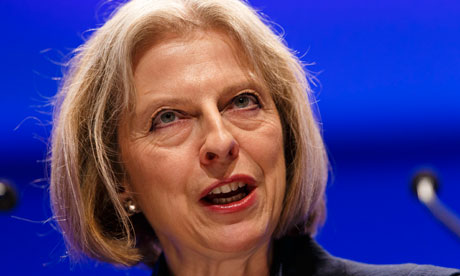 The Home Office is extraordinarily sensitive about its use of the power, but it is known that Theresa May has deprived at least 17 people of their British citizenship. Photograph: Chris Ison/PA
The Home Office is extraordinarily sensitive about its use of the power, but it is known that Theresa May has deprived at least 17 people of their British citizenship. Photograph: Chris Ison/PA
This power can be applied only to dual nationals, and those who lose their citizenship can appeal. The government appears usually to wait until the individual has left the country before moving to deprive them of their citizenship, however, and appeals are heard at the highly secretive special immigration appeals commission (SIAC), where the government can submit evidence that cannot be seen or challenged by the appellant.
The Home Office is extraordinarily sensitive about the manner in which this power is being used. It has responded to Freedom of Information Act requests about May's increased use of this power with delays and appeals; some information requested by the Guardian in June 2011 has still not been handed over. What is known is that at least 17 people have been deprived of their British citizenship at a stroke of May's pen. In most cases, if not all, the home secretary has taken action on the recommendation of MI5. In each case, a warning notice was sent to the British home of the target, and the deprivation order signed a day or two later.
One person who lost their British citizenship in this way was Anna Chapman, a Russian spy, but the remainder are thought to all be Muslims. Several of them – including a British-Pakistani father and his three sons – were born in the UK, while most of the others arrived as children. And some have been deprived of their citizenship not because they were assessed to be involved in terrorism or any other criminal activity, but because of their alleged involvement in Islamist extremism.
Berjawi and Sakr both travelled to Somalia after claiming that they were being harassed by police in the UK, and were then stripped of their British citizenship. Several months later they were killed. The exact nature of any intelligence that the British government may have shared with Washington before their names were apparently entered into the disposition matrix is deeply secret: the UK has consistently refused to either confirm or deny that it shares intelligence in support of drone strikes, arguing that to do so would damage both national security and relations with the US government.
More than 12 months after Sakr's death, his father, Gamal, a businessman who settled in London 37 years ago, still cannot talk about his loss without breaking down and weeping. He alleges that one of his two surviving sons has since been harassed by police, and suspects that this boy would also have been stripped of his citizenship had he left the country. "It's madness," he cries. "They're driving these boys to Afghanistan. They're making everything worse."
Last year Gamal and his wife flew to Cairo, formally renounced their Egyptian citizenship, and on their return asked their lawyer to let it be known that their sons were no longer dual nationals. But while he wants his family to remain in Britain, the manner in which his son met his death has shattered his trust in the British government. "It was clearly directed from the UK," he says. "He wasn't just killed: he was assassinated."
The case of Mahdi Hashi
Mahdi Hashi was five years old when his family moved to London from Somalia. He returned to the country in 2009, and took up arms for al-Shabaab in its civil war with government forces. A few months earlier he had complained to the Independent that he been under pressure to assist MI5, which he was refusing to do. Hashi was one of a few dozen young British men who have followed the same path: in one internet video clip, an al-Shabaab fighter with a cockney accent can be heard urging fellow Muslims "living in the lands of disbelief" to come and join him. It is thought that the identities of all these men are known to MI5.
After the deaths of Berjawi and Sakr, Hashi was detained by al-Shabaab, who suspected that he was a British spy, and that he was responsible for bringing the drones down on the heads of his brothers-in-arms. According to his US lawyer, Harry Batchelder, he was released in early June last year. The militants had identified three other men whom they believed were the culprits, executing them shortly afterwards.
Within a few days of Hashi's release, May signed an order depriving him of his British citizenship. The warning notice that was sent to his family's home read: "The reason for this decision is that the Security Service assess that you have been involved in Islamist extremism and present a risk to the national security of the United Kingdom due to your extremist activities."
Hashi decided to leave Somalia, and travelled to Djibouti with two other fighters, both Somali-Swedish dual nationals. All three were arrested in a raid on a building, where they had been sleeping on the roof, and were taken to the local intelligence agency headquarters. Hashi says he was interrogated for several weeks by US intelligence officers who refused to identify themselves. These men then handed him over to a team of FBI interrogators, who took a lengthy statement. Hashi was then hooded, put aboard an aircraft, and flown to New York. On arrival he was chargedwith conspiracy to support a terrorist organisation.
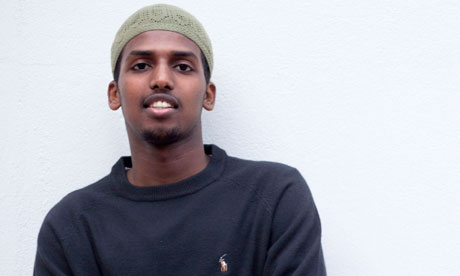 Mahdi Hashi ... arrested and taken to court in the US after having his British citizenship revoked. Photograph: Teri Pengilley
Mahdi Hashi ... arrested and taken to court in the US after having his British citizenship revoked. Photograph: Teri Pengilley
Hashi has since been quoted in a news report as saying he was tortured while in custody in Djibouti. There is reason to doubt that this happened, however: a number of sources familiar with his defence case say that the journalist who wrote the report may have been misled. And the line of defence that he relied upon while being interrogated – that Somalia's civil war is no concern of the US or the UK – evaporated overnight when al-Shabaab threatened to launch attacks in Britain.
When Hashi was led into court in Brooklyn in January, handcuffed and dressed in a grey and orange prison uniform, he was relaxed and smiling. The 23-year-old had been warned that if he failed to co-operate with the US government, he would be likely to spend the rest of his life behind bars. But he appeared unconcerned.
At no point did the UK government intervene. Indeed, it cannot: he is no longer British.
When the Home Office was asked whether it knew Hashi was facing detention and forcible removal to the US at the point at which May revoked his citizenship, a spokesperson replied: "We do not routinely comment on individual deprivation cases, nor do we comment on intelligence issues."
The Home Office is also refusing to say whether it is aware of other individuals being killed after losing their British citizenship. On one point it is unambiguous, however. "Citizenship," it said in a statement, "is a privilege, not a right."
The case of 'B2'
A glimpse of even closer UK-US counter-terrorism co-operation can be seen in the case of the Vietnamese-born convert, who cannot be named for legal reasons. Born in 1983 in the far north of Vietnam, he was a month old when his family travelled by sea to Hong Kong, six when they moved to the UK and settled in London, and 12 when he became a British citizen.
While studying web design at a college in Greenwich, he converted to Islam. He later came into contact with the banned Islamist group al-Muhajiroun, and was an associate of Richard Dart, a fellow convert who was the subject of a TV documentary entitled My Brother the Islamist, and who was jailed for six years in April after travelling to Pakistan to seek terrorism training. In December 2010, this man told his eight-months-pregnant wife that he was going to Ireland for a few weeks. Instead, he travelled to Yemen and stayed for seven months. MI5 believes he received terrorism training from al-Qaida in the Arabian peninsula and worked on the group's online magazine, Inspire.
He denies this. Much of the evidence against him comes from a man called Ahmed Abdulkadir Warsame, a Somali who once lived in the English midlands, and who was "rendered to justice" in much the same way as Hashi after being captured in the Gulf of Aden two years ago. Warsame is now co-operating with the US Justice Department.
On arrival back at Heathrow airport, the Vietnamese-born man was searched by police and arrested when a live bullet was found in his rucksack. A few months later, while he was free on bail, May signed an order revoking his British citizenship. Detained by immigration officials and facing deportation to Vietnam, he appealed to SIAC, where he was given the cipher B2. He won his case after the Vietnamese ambassador to London gave evidence in which he denied that he was one of their citizens. Depriving him of British citizenship at that point would have rendered him stateless, which would have been unlawful.
Within minutes of SIAC announcing its decision and granting B2 unconditional bail, he was rearrested while sitting in the cells at the SIAC building. The warrant had been issued by magistrates five weeks earlier, at the request of the US Justice Department. Moments after that, the FBI announced that B2 had been charged with five terrorism offences and faced up to 40 years in jail. He was driven straight from SIAC to Westminster magistrates' court, where he faced extradition proceedings.
B2 continues to resist his removal to the US, with his lawyers arguing that he could have been charged in the UK. Indeed, the allegations made by the US authorities, if true, would appear to represent multiple breaches of several UK laws: the Terrorism Act 2000, the Terrorism Act 2006 and the Firearms Act 1968. Asked why B2 was not being prosecuted in the English courts – why, in other words, the Americans were having this particular headache, and not the British – a Crown Prosecution Service spokesperson said: "As this is a live case and the issue of forum may be raised by the defence in court, it would be inappropriate for us to discuss this in advance of the extradition hearing."
The rule of 'imminent threat'
In the coffee shops of west London, old friends of Berjawi, Sakr, Hashi and B2 are equally reluctant to talk, especially when questioned about the calamities that have befallen the four men. When they do, it is in a slightly furtive way, almost in whispers.
Ezzouek explains that he never leaves the country any more, fearing he too will be stripped of his British citizenship. Al-Daour is watched closely and says he faces recall to prison whenever he places a foot wrong. Failing even to tell his probation officer that he has bought a car, for example, is enough to see him back behind bars. A number of their associates claim to have learned of the deaths of Berjawi and Sakr from MI5 officers who approached them with the news, and suggested they forget about travelling to Somalia.
Last February, a 16-page US justice department memo, leaked to NBC News, disclosed something of the legal basis for the drone programme. Its authors asserted that the killing of US citizens is lawful if they pose an "imminent threat" of violent attack against the US, and capture is impossible. The document adopts a broad definition of imminence, saying no evidence of a specific plot is needed, and remains silent on the fate that faces enemies who are – or were – citizens of an allied nation, such as the UK.
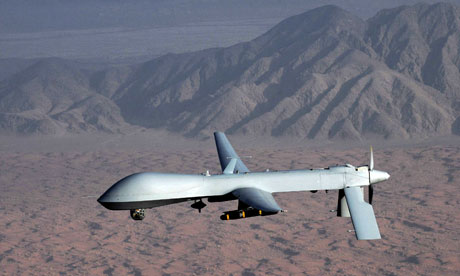 Londoner Bilal Berjawi died in a drone strike. Photograph: Sipa Press/Rex Features
Londoner Bilal Berjawi died in a drone strike. Photograph: Sipa Press/Rex Features
But if the Obama administration is satisfied that the targeted killing of US citizens is lawful, there is little reason to doubt that young men who have been stripped of their British citizenship, and who take up arms in Somalia or Yemen or elsewhere, will continue to find their way on to the disposition matrix, and continue to be killed by missiles fired from drones hovering high overhead, or rendered to courts in the US.
And while Obama says he wants to curtail the drone programme, his officials have been briefing journalists that they believe the operations are likely to continue for another decade, at least. Given al-Qaida's resilience and ability to spread, they say, no clear end is in sight.
Nenhum comentário:
Postar um comentário